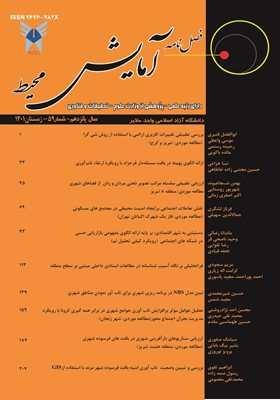تبین مدل NBS در برنامهریزی شهری برای تابآور نمودن مناطق شهری
محورهای موضوعی : آمایش محیطحسین شیرمحمدی 1 , مجید شمس 2 *
1 - دانشجوی دکتری جغرافیا و برنامهریزی شهری، واحد ملایر، دانشگاه آزاد اسلامی، ملایر، ایران
2 - استاد جغرافیا و برنامهریزی شهری، واحد ملایر، دانشگاه آزاد اسلامی، ملایر، ایران
کلید واژه: مدل, NBS, تابآوری برنامهریزی شهری, چالش شهری,
چکیده مقاله :
شهرها با چالشهای زیستمحیطی، اجتماعی و اقتصادی فزایندهای مواجه بوده که در کنار هم تابآوری شهری را تهدید میکنند. مناطق شهری و ساکنانی که در آنجا زندگی و کار میکنند، همواره در معرض استرسهای مزمن، حاد و شوکها، بوده که با تأثیرات محیط طبیعی از جمله تغییر اقلیم، زلزله، سیل و... تقویت میشوند و از آن جایی که جمعیت جهان در حال افزایش است و از 7.7 میلیارد در سال 2020 به 9.7 میلیارد در سال 2050 تخمین زده میشود، مشکلات و چالشهای بیشمار دیگری نیز از جمله شیوع اپیدمیهای فرگیر را پیش رو خواهد داشت. در این بین برنامهریزی شهری در پی آن است که با تغییر رویکرد به تابآوری شهری کمک نماید. لذا تابآوری شهری مفهومی است که با برنامهریزی شهری تقویت میشود. یکی از این راه حلهای افزایش تابآوری مجموعه اقداماتی با عنوان راهحلهای مبتنی بر طبیعت NBS ست این راه حلها برگرفته از یک رویکرد سیستمی برای تقویت نگهداری، بهبود و احیای تنوع زیستی و اکوسیستمها در مناطق شهری، گسترش منابع زیرساخت سبز و سازگاری اقلیم مبتنی بر اکوسیستم است.
Cities are facing increasing environmental, social, and economic challenges that threaten urban resilience, urban areas, and residents who live and work there. It has always been exposed to chronic, acute stress and shocks, which are strengthened by the effects of the natural environment, such as climate change, earthquakes, floods, etc. And since the world's population is increasing and it is estimated from 7.7 billion in 2020 to 9.7 billion in 2050, it will face countless other problems and challenges, including the spread of widespread epidemics. In the meantime, urban planning seeks to help urban resilience by changing the approach. Therefore, urban resilience is a concept that is strengthened by urban planning. One of these solutions to increase resilience is a set of measures called nature-based solutions (NBS). These solutions are derived from a systemic approach to strengthen the maintenance, improvement, and restoration of biodiversity and ecosystems in urban areas, and to expand green infrastructure resources, and climate adaptation based on the ecosystem.
Tachtler. Frantzeskaki 2019 Supporting the Supporters of Unaccompanied Migrant Youth: Designing for Social-ecological Resilience. HI '20: Proceedings of the 2020 CHI Conference on Human Factors in Computing Systems.
_||_

